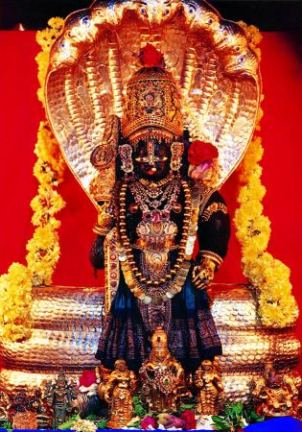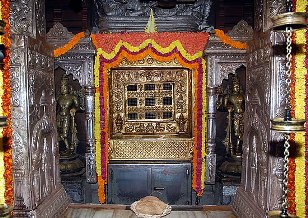 Udupi is one of the holiest towns in the country and is one of the seven 'Mukthi Sthalams' in the state of Karnataka. Sri Madhavacharya, The great Hindu saint and proponent of the 'Dwaitha' school of philosophy has consecrated the statue of Lord Sri Krishna here. Incidentally, Udupi is also the birthplace of this great saint. Apart from the popular Sri Krishna Mutt, Udupi is also home to many ancient temples like the Chandramouleeswara Temple and the Anantheswara Temple. Udupi attracts hundreds of thousands of pilgrims each year during the festive occasions of Saptotsava and Paryayotsava. Constructed in the Dravidian style of temple architecture, the whole place resembles a hermitage. The entrance is carved quite brilliantly with images of Gods. Inside the sanctum, the Lord is decorated brilliantly with jewels and perhaps the most interesting aspect is that pilgrims can have a glimpse of the Lord through a window that is pierced with a hole, known popularly as the 'Kanakanakindi'. The temple activities are administered on a rotation basis every two years by eight 'mutts' or religious bodies. These eight 'mutts' are from the eight disciples of Sri Madhavacharya that were granted 'Sanyasa' by the great saint philosopher. The eight 'mutts' are Sri Palimar Mutt, Sri Admar Mutt, Sri Krishnapur Mutt, Sri Puttige Mutt, Sri Sirur Mutt, Sri Sode Mutt, Sri Kaniyoor Mutt and Sri Pejavar Mutt.
Udupi is one of the holiest towns in the country and is one of the seven 'Mukthi Sthalams' in the state of Karnataka. Sri Madhavacharya, The great Hindu saint and proponent of the 'Dwaitha' school of philosophy has consecrated the statue of Lord Sri Krishna here. Incidentally, Udupi is also the birthplace of this great saint. Apart from the popular Sri Krishna Mutt, Udupi is also home to many ancient temples like the Chandramouleeswara Temple and the Anantheswara Temple. Udupi attracts hundreds of thousands of pilgrims each year during the festive occasions of Saptotsava and Paryayotsava. Constructed in the Dravidian style of temple architecture, the whole place resembles a hermitage. The entrance is carved quite brilliantly with images of Gods. Inside the sanctum, the Lord is decorated brilliantly with jewels and perhaps the most interesting aspect is that pilgrims can have a glimpse of the Lord through a window that is pierced with a hole, known popularly as the 'Kanakanakindi'. The temple activities are administered on a rotation basis every two years by eight 'mutts' or religious bodies. These eight 'mutts' are from the eight disciples of Sri Madhavacharya that were granted 'Sanyasa' by the great saint philosopher. The eight 'mutts' are Sri Palimar Mutt, Sri Admar Mutt, Sri Krishnapur Mutt, Sri Puttige Mutt, Sri Sirur Mutt, Sri Sode Mutt, Sri Kaniyoor Mutt and Sri Pejavar Mutt.
History
This ancient temple can be dated to the thirteenth century CE, which is when the great saint Sri Madhavacharya consecrated the Lord's image here.
Legends
Udupi being a 'Mukthi Sthala' of Karnataka has many popular legends associated with it. The most popular legend is that of Sri Madhavacharya rescuing a ship struck in a storm. Legend has it that once while Sri Madhavacharya was offering his morning prayers on the shores of Malpe, a ship struck in a storm off the coast caught his attention and the great saint rescued the ship by controlling the weather through his meditative powers. To the utter astonishment of the crew, the ship sailed safely to the shores on its own. The captain found the saint on the shores, understood the miracle to be an act of the great Sri Madhavacharya, and offered him the entire cargo. The saint refused all of it except the images of Lord Sri Krishna and Lord Balarama and consecrated the image of the Lord Sri Krishna at this place. Legend also has it that Sri Madhavacharya bathed the image of Lord Sri Krishna at a pond that became today's Madhava Sarovar. The image that was installed by Sri Madhavacharya is actually from the holy city of Dwaraka and is covered by holy Sandalwood paste. There are many versions to this legend.
Another popular legend is that of an ardent devotee of the Lord named Kanakadasa. According to the legend, Kanakadasa, an ardent devotee of Lord Sri Krishna, was not allowed to worship the Lord as he was from a lower section of the society. However, this did not deter the devotee and the incident only served to firm his resolve further. He intensified his prayers and succeeded in pleasing the Lord, who fulfilled his wish by turning himself to face the window at the back and presenting a glimpse of his image through a small hole created in the window. This window is the popular 'Kanakanakindi'. The Kanakadasa road here is named so in the honor of this devotee.
There is also the popular legend of Lord Parasurama, an incarnation of Lord Vishnu, who is believed to be the creator of the Land from Gokarna to Cape Comorin in Kerala by reclaiming land from the Arabian Sea. The Legend of the Moon God performing a Yajna here to relieve himself from the curse of Daksha Prajapathi, the father in-law of Lord Shiva, is also quite popular and may have led to the name this place as Udupi – Udu (Sanskrit for Stars) and Pa (Sanskrit for Lord of). As the Moon is considered the king of stars, the place became Udupi.
 Festivals
Festivals
The most popular are the Saptotsavam and the Paryayotsavam. These festivals draw huge crowds from all across the country and the whole town gets electric.
The Saptotsava falls in the month of January and is celebrated for seven days in a grand fashion. Celebrations start five days before the Makara Sankramana and conclude on the next day of Makara Sankramana.
Every two years the festival of Paryayotsavam is celebrated. The event is basically a hand over ceremony as tradition has it that every two years, one of the eight 'mutts' established by the 'Sanyasa' disciples of Sri Madhavacharya takes charge of the worship services at the temple. This festival too falls in mid January of every alternate year. The period of change of guard used to be once every two months and was changed to two years by Sri Vadiaraja, probably around the sixteenth century CE.
Sri Madhava Navami is another major festival celebrated here and generally falls in the month of February. This celebration honors the great saint Sri Madhavacharya.
The Holy Kamadahana, Sri Rama Navami, Narasimha Jayanthi, Subhramanya Sashti, Navaratri, Diwali, Sri Krishna Jayanthi and the popular Laksha Deepotsava in October/November are some of the other important festivals that are celebrated at Udupi.
Places of Interest
Udupi is holy town and has a lot to offer to the religious traveler. Popular attractions include:
- The temples of Sri Chandramouleeswara, Sri Anantheswara, Sri Venkataramana, Sri Sankaranarayana, Sri Subhramanyeswara and Sri Saradha at Udupi.
- Shri Durga Temples at Indrali, Kannarpadi and Puttur.
- The Mahishasura Mardini Temple at Bailur and Sri Venu Goplalaswamy temple at Manipal.
Accommodation
Udupi is major tourist destination and offers a wide range of accommodative options to choose from. The place is also known for its famous cuisine. Staying at Mangalore, an hour's drive, is also an option.